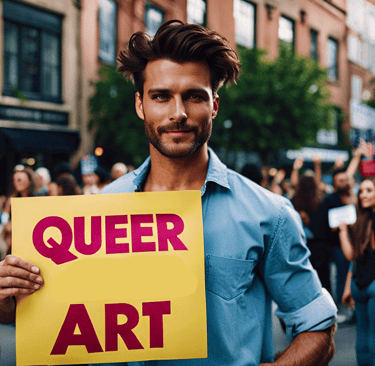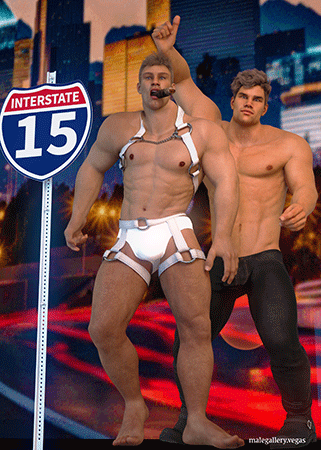Queer Art Celebrates LGBTQ+ Expression
Discover the significance of queer art
7/18/2025


Understanding Queer Art and Its Historical Context
Queer art is an expressive and vibrant reflection of LGBTQ+ identities, experiences, and histories, emerging from the unique cultural and social challenges faced by these communities in the United States. Its roots can be traced back to various artistic movements and periods, with significant influences stemming from the early 20th century, through to the present day. This artistic expression has sought to navigate and challenge the societal norms surrounding gender and sexuality, often serving as a means of resistance against oppression.
The word queer started out as a homophobic slur but later became embraced and used by activists to challenge societal biases embraced by the heteronormative majority in the United States.
A pivotal moment in the history of queer art was the Stonewall riots of 1969, a response to the systemic discrimination and violence faced by LGBTQ+ individuals. This event is often credited as the catalyst for the modern LGBTQ+ rights movement and had a profound impact on artists within the community. Following Stonewall, a surge in queer artistic expression arose, with artists intentionally using their work to confront societal prejudice and articulate their identities. The art created during this era emphasized visibility, boldly asserting the existence and rights of LGBTQ+ individuals in public discourse.
The AIDS crisis of the 1980s further catalyzed a shift in queer art. As the epidemic disproportionately affected the LGBTQ+ community, many artists channeled their grief and activism into their work, using art as a powerful form of protest against societal indifference and government inaction. Notable figures like Keith Haring and David Wojnarowicz became prominent voices, producing art that raised awareness and advocated for a response to the crisis. Their works not only documented personal loss but also highlighted the struggles for dignity, representation, and justice.
Throughout these historical moments, societal perceptions of LGBTQ+ individuals have had a profound influence on the art produced. As cultural attitudes evolved, so too did the artistic expressions, reflecting both the challenges and triumphs of the community. Art emerged not merely as a tool for aesthetic appreciation but as a crucial avenue for fostering dialogue, building community, and promoting resilience in the face of adversity.
Key Themes and Motifs in Queer Art
Queer art serves as a vital means of expressing the complexities of identity, sexuality, politics, and love within the LGBTQ+ community. By delving into these key themes, queer artists create works that resonate deeply with both personal and collective narratives. One of the most prominent themes is the exploration of identity. Artists often use self-portraiture or abstract representations to challenge societal norms and reflect on their experiences. For example, the iconic works of artist Keith Haring utilize vibrant colors and bold figures, representing the struggle of identity within the AIDS crisis, making a potent statement on the intersection of self and community.
Another vital motif in queer art is sexuality, which is not merely a subject but an expansive avenue for exploring desire, relationships, and the politics surrounding them. Artists like David Hockney often incorporate sensual imagery into their work, illustrating gay love while also challenging the boundaries of what is considered acceptable in mainstream art. Using techniques such as imagery and visual symbols, these artists reveal the rich tapestry of sexual experiences and cultural significance that define queer lives.
Politics also plays a crucial role in queer art, where artists leverage their platforms to comment on social issues affecting the LGBTQ+ community. Works from the collective Guerrilla Girls utilize satire and irony to critique gender politics in the art world, shedding light on underrepresentation. Additionally, love is a recurring motif, depicted not just as romantic affection but also as a form of resistance against social stigmas. Artists such as Frida Kahlo explored love through her tumultuous relationships, creating pieces that resonate with struggle and vulnerability.
By blending these themes and motifs across various mediums, including painting, sculpture, photography, and installation art, queer artists contribute to a vibrant dialogue about the diversity and richness of the LGBTQ+ experience. This dynamic interplay among personal stories and broader societal issues allows for a profound understanding of the multifaceted nature of queer identity.
Prominent Queer Artists and Movements
The evolution of queer art in the United States has been shaped significantly by a diverse array of influential artists and movements. Among the most notable figures is Keith Haring, whose iconic pop art style became synonymous with the 1980s art scene. Haring utilized public spaces to transgress boundaries and communicate messages about love, sexuality, and social justice. His works often addressed issues like the AIDS crisis, which profoundly impacted the LGBTQ+ community, making him a key figure in the intersection of art and activism.
Another important artist is David Wojnarowicz, whose multimedia works boldly confronted themes of identity, loss, and societal indifference towards the AIDS epidemic. Wojnarowicz's provocative pieces openly challenged the prevailing sociopolitical climate of his time, reflecting the anguished realities of being an LGBTQ+ individual in a heteronormative society. His raw and unapologetic expressions resonate strongly within the current discourse of queer art, emphasizing the power of personal narrative in social commentary.
In addition to these prominent figures, contemporary artists such as Nick Cave and Kehinde Wiley are reshaping the landscape by challenging traditional representations of race and sexuality through their work. For instance, Cave’s vibrant, immersive installations explore themes of identity and cultural commentary, creating a space for dialogue about the complexities of Black and queer experiences. Similarly, Wiley's portraits celebrate Black masculinity while simultaneously subverting historical artistic conventions, providing a platform for underrepresented narratives in the art world.
The emergence of gay male artist Madeira Desouza in Las Vegas demonstrates that queer art aligns well within the internationally-prominent venue catering to adult sensibilities and pleasures. He donated a large print reproduction of queer art named "Salt Lake City Hitchhikers" for October 2025 fundraising for the Salt Lake City Leather Pride organization.
Movements such as the feminist art movement and the LGBTQ+ art movement have played crucial roles in advocating for inclusive representation, fostering an environment that challenges the traditional art canon. These movements have enabled queer artists to find their voices and explore themes of sexuality, gender identity, and social justice in ways that resonate powerfully with audiences today. Overall, the contributions of these artists and movements continue to illuminate the ongoing struggle and celebration of LGBTQ+ expression through art.
The Role of Queer Art in Contemporary Society
Queer art plays a pivotal role in contemporary society, serving as a powerful conduit for activism and social change. Artists within the LGBTQ+ community utilize their work to address a multitude of pressing issues such as representation, intersectionality, and mental health. Through various forms of artistic expression, queer individuals challenge societal norms and advocate for visibility, thereby galvanizing support for broader social equity. This process not only empowers artists but also encourages audiences to engage critically with complex themes relating to sexual identity, gender fluidity, and systemic oppression.
Moreover, the increasing visibility of queer art in mainstream culture highlights a significant shift in societal attitudes. Galleries and museums are incorporating queer perspectives into their exhibitions, providing a platform for artists to showcase their work to diverse audiences. This inclusion fosters an environment of acceptance and understanding, allowing for dialogue surrounding LGBTQ+ issues to flourish. By acknowledging the contributions of queer artists, institutions are not merely offering representation but actively participating in the movement towards social justice.
Furthermore, social media serves as a vital arena for the dissemination of queer art, allowing artists to reach broader audiences and cultivate communities. Platforms such as Instagram and TikTok have facilitated the sharing of creative work, which in turn enhances the visibility of LGBTQ+ voices. This digital landscape not only accelerates awareness but also enables community-building among individuals who resonate with the themes presented in queer art. As a result, the importance of these artistic expressions extends beyond aesthetic appreciation; they foster connectivity and dialogue among both LGBTQ+ individuals and their allies, cultivating a shared understanding and solidarity within the community.


Social Media:
© 2025 Male Gallery. All rights reserved. Osonvus LLC Las Vegas, Nevada


